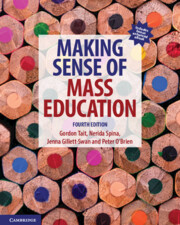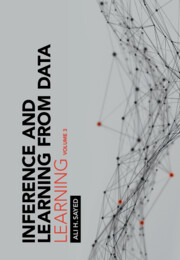Refine search
Actions for selected content:
36807 results in Cambridge Textbooks

Making Sense of Mass Education
-
- Published online:
- 28 February 2023
- Print publication:
- 10 January 2023
-
- Textbook
- Export citation

Inference and Learning from Data
- Learning
-
- Published online:
- 24 February 2023
- Print publication:
- 22 December 2022
-
- Textbook
- Export citation
Copyright page
-
- Book:
- Structural Dynamics
- Published online:
- 31 March 2023
- Print publication:
- 23 February 2023, pp vi-vi
-
- Chapter
- Export citation
Appendix: - Some Useful Mathematical Concepts
-
- Book:
- Hydrology
- Published online:
- 01 March 2023
- Print publication:
- 23 February 2023, pp 595-603
-
- Chapter
- Export citation
Reviews
-
- Book:
- Structural Dynamics
- Published online:
- 31 March 2023
- Print publication:
- 23 February 2023, pp iv-iv
-
- Chapter
- Export citation
Preface
-
- Book:
- Structural Dynamics
- Published online:
- 31 March 2023
- Print publication:
- 23 February 2023, pp xvii-xx
-
- Chapter
- Export citation
5 - Natural Modes of Vibration: Discrete Systems
-
- Book:
- Structural Dynamics
- Published online:
- 31 March 2023
- Print publication:
- 23 February 2023, pp 245-311
-
- Chapter
- Export citation
4 - The Right to Freedom of Expression and of Information
-
-
- Book:
- Fundamental Rights
- Published online:
- 02 March 2023
- Print publication:
- 23 February 2023, pp 81-115
-
- Chapter
- Export citation
8 - The Right to Respect for Family Life and the Right to Marry
-
-
- Book:
- Fundamental Rights
- Published online:
- 02 March 2023
- Print publication:
- 23 February 2023, pp 233-258
-
- Chapter
- Export citation
11 - The Right to Life and the Prohibition of the Death Penalty
-
-
- Book:
- Fundamental Rights
- Published online:
- 02 March 2023
- Print publication:
- 23 February 2023, pp 309-339
-
- Chapter
- Export citation
19 - The Right to Health
-
-
- Book:
- Fundamental Rights
- Published online:
- 02 March 2023
- Print publication:
- 23 February 2023, pp 487-507
-
- Chapter
- Export citation
8 - Structural Dynamics of Rotating Systems
-
- Book:
- Structural Dynamics
- Published online:
- 31 March 2023
- Print publication:
- 23 February 2023, pp 444-486
-
- Chapter
- Export citation
20 - The Right to Environmental Protection and Sustainable Development
-
-
- Book:
- Fundamental Rights
- Published online:
- 02 March 2023
- Print publication:
- 23 February 2023, pp 508-521
-
- Chapter
- Export citation
6 - Overland Flow
- from Part II - Water on the Surface
-
- Book:
- Hydrology
- Published online:
- 01 March 2023
- Print publication:
- 23 February 2023, pp 216-232
-
- Chapter
- Export citation
Copyright page
-
- Book:
- Hydrology
- Published online:
- 01 March 2023
- Print publication:
- 23 February 2023, pp iv-iv
-
- Chapter
- Export citation
Part I - Water in the Atmosphere
-
- Book:
- Hydrology
- Published online:
- 01 March 2023
- Print publication:
- 23 February 2023, pp 21-180
-
- Chapter
- Export citation
4 - Evaporation
- from Part I - Water in the Atmosphere
-
- Book:
- Hydrology
- Published online:
- 01 March 2023
- Print publication:
- 23 February 2023, pp 130-180
-
- Chapter
- Export citation
Appendices
-
- Book:
- Structural Dynamics
- Published online:
- 31 March 2023
- Print publication:
- 23 February 2023, pp 509-556
-
- Chapter
- Export citation
Appendix B - Laplace Transforms
-
- Book:
- Structural Dynamics
- Published online:
- 31 March 2023
- Print publication:
- 23 February 2023, pp 542-550
-
- Chapter
- Export citation
Contents
-
- Book:
- Structural Dynamics
- Published online:
- 31 March 2023
- Print publication:
- 23 February 2023, pp ix-xvi
-
- Chapter
- Export citation
